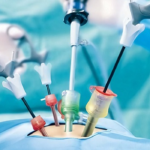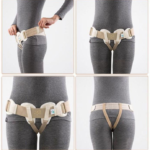Inguinal hernia surgery
In modern surgery, surgery is the only way to treat inguinal hernias. The doctor is faced with the task of not only removing the formed hernial sac and adjusting its contents, but also in preventing the recurrence of the disease by performing inguinal hernia hernioplasty.
An inguinal hernia is the result of a weakening of the wall of the inguinal gap and the release of the contents of the abdominal cavity into the inguinal canal. There are hernias that are not complicated and restrained. The latter are more dangerous for humans, as they are fraught with the development of necrosis, an infectious process, and impaired intestinal patency.
Indications and contraindications for surgery
When diagnosing an inguinal hernia, the issue of surgical intervention is decided. The sooner the operation to remove the inguinal hernia is performed, the higher the chance of avoiding complications. To confirm the diagnosis and differential diagnosis with a femoral hernia, it is enough for the doctor to examine and palpate the protrusion in the groin.
There are a number of contraindications to the operation to remove a hernia:
- decompensated diseases of the cardiovascular and pulmonary systems;
- cirrhosis of the liver with symptoms of portal hypertension;
- chronic kidney disease;
- pregnancy.
Preparing for the operation
In the preoperative period, the patient will have to pass a series of tests and adhere to certain rules. At this stage, conditions can be diagnosed that are a contraindication to surgical intervention, or an indication for postponing surgery for a certain period.
The following tests are required:
- clinical (general) blood test;
- blood biochemistry;
- Wasserman reaction (for syphilis);
- analysis for the presence of antibodies to hepatitis B, C viruses;
- HIV test;
- ECG.
If there is a history of concomitant diseases, additional studies are carried out:
- Analysis of urine;
- chest x-ray;
- Abdominal ultrasound.
Preparation for a planned operation involves a complete rejection of the use of alcohol, tobacco and drugs. Patients who are forced to take any drugs for health reasons should inform the doctor about this. You should adjust your diet, limit the amount of food consumed and give preference to soft and light meals.
The day before the operation, dinner should be no later than seven in the evening. In case of strong excitement, you can take a light sleeping pill to ensure yourself a full 8-hour sleep. In the morning, immediately before the procedure, it is forbidden to eat and drink, the patient is given a cleansing enema and sent to the operating room.
The main stages of the operation
Removal of an inguinal hernia in modern medicine is a routine operation for any abdominal surgeon. There are more than three hundred types of operations to remove a hernia, many of which are still in use today. The operation for this pathology, like any surgical intervention, takes place in several stages. Each of them has its own characteristics depending on the type of hernia.
Anesthesia
At the first stage of the operation, anesthesia is performed: local or general. If a person arrives with an uncomplicated hernia, then it is more appropriate to use local anesthesia. This method can also be chosen if the patient has contraindications to general anesthesia. In the case of a complicated hernia, for example, its infringement, or in case of recurrence, the doctor prefers general anesthesia.
The first stage of the operation
surgical access. There are three access options:
- Open - the standard method, used longer than others. However, with the advent of laparoscopy, its popularity is declining.
- Laparoscopic is a less traumatic type of surgical access. Reduces the likelihood of hernia recurrence to a minimum.
- Combined - a method in which part of the operation is performed with open access, and part using a laparoscope.
The second stage of the operation - hernia repair
There are two main points during this phase:
Hernia repair with open access
This is a direct opening of the hernia and the reduction of its contents. The doctor dissects the tissues in layers over the protrusion area, highlights the bottom and body of the hernial sac. After opening it, it is imperative to revise the organs that are in the bag, since at this stage inflammatory or necrotic changes can be detected. In the absence of such, the contents of the hernial sac are reduced into the abdominal cavity. The hernial sac itself in the cervical area is cut off and sutured.
Hernia repair during laparoscopy
During the operation, a special device is used - a laparoscope, which is inserted through the trocar into the abdominal cavity. Through two more trocars, the instruments necessary to open the peritoneum from the inside, eliminate the protrusion and close the defect in the wall of the inguinal canal are inserted.
This method is not suitable for all patients, as it involves the use of general anesthesia. It is also carried out for those who do not have any systemic diseases.
The chosen method of hernia repair depends on:
- The size of postoperative scars. Obviously, with the laparoscopic method, they will be minimal and almost invisible.
- Pain syndrome, which is more pronounced with open surgery for inguinal hernia.
- The speed of rehabilitation and the opportunity to return to a normal lifestyle. With open access, the scar is formed for about four months and all this time the patient has limitations in physical activity. With laparoscopic access, rehabilitation takes 14 days.
The third stage - hernioplasty
This is the next step after removal of the hernial sac. The walls of the inguinal canal are strengthened to prevent possible relapses. Methods of plastic surgery for inguinal hernia were combined into two large groups:
- Tension hernioplasty with the patient's own tissues - strengthening the wall of the inguinal canal is carried out using the patient's muscular aponeurotic plate.
The main method on which more modern plastic methods are based is according to Bassini. The essence of the operation is that the muscles that form the deep layer of the anterolateral wall of the abdomen are sutured to the inguinal ligament. Thus, they stretch and strengthen the back wall of the inguinal canal, the place where hernias pass. The anterior wall is formed by suturing the ends of the aponeurosis of the external oblique muscle of the abdomen.
- Tension-free hernioplasty is a newer and more promising way to strengthen the walls with the help of additional materials (both biological and artificial).
For several centuries, doctors have improved the methods of plastic surgery, and in the end they found a method that today is the "gold standard". This is Liechtenstein hernioplasty. The method refers to a tension-free method of strengthening the walls of the inguinal canal and is based on the use of synthetic materials.
The mesh for the operation is made of polypropylene - a material that perfectly takes root in the body and does not cause an immune response. At the same time, natural human tissues are practically not damaged or stretched, so the likelihood of relapse with this method is reduced to a minimum.
The method of strengthening the weak points of the inguinal region after hernia repair with the help of artificial materials is called alloplasty. Weakened inguinal spaces are reinforced with mesh either laparoscopically or openly.
Operation duration
It is impossible to say unequivocally how long the operation lasts, since this figure is individual. It depends on the severity of the pathological process, the general condition of the patient, the professionalism of the surgeon, the method of hernia repair chosen by the doctor, and much more. On average, an operation with an open access will take from an hour to an hour and a half, and with a laparoscopy one hour.
Postoperative period
After the patient has been operated on, he is obliged to follow all the instructions of the doctor, because the success of the operation largely depends on how the postoperative period goes.
The formation of a scar with open access goes through a number of stages and it is important not to disturb this process. The body will recover for a long time - up to 4 months. A few days after the operation, the patient is discharged home, where he must remain in bed for another week.
Whether it is necessary to wear a bandage during this period is up to the doctor, but most likely it will be needed a little later, at a time when the patient will need to return to a normal lifestyle. It is impossible to completely avoid physical activity, since in small quantities it contributes to the natural strengthening of the walls and the prevention of recurrence of inguinal hernia.
The rehabilitation period for laparoscopy is shorter and much easier. On the day of the operation, the patient can walk, and the next day he can return home. Children and patients with comorbidities may be detained for several days in the hospital and observed. Two weeks should refrain from physical activity, long walking and driving. After that, you can return to your normal lifestyle.
Price
To understand how much an inguinal hernia operation costs, the following points should be considered:
- the city in which the clinic is located;
- prestige of a medical institution;
- doctor's professionalism;
- the chosen method of operation;
- the degree of the disease, the size of the hernia;
- type of anesthesia used.
Below is the average cost of the operation in Moscow and Moscow Region. Prices may be lower in other cities.
- Open access + plasty with own tissues + anesthesia ≈ 20,000 rubles.
- Open access + hernia repair with mesh + anesthesia ≈ 30,000 rubles.
- Laparoscopic access + alloplasty + anesthesia ≈ 45,000 rubles.










